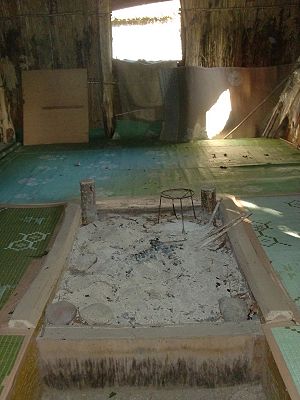Ainu people: Difference between revisions
Jump to navigation
Jump to search

imported>John Stephenson (New page: {{subpages}} <!-- Text is transcluded from the BASEPAGENAME/Definition subpage-->) |
imported>John Stephenson (stub) |
||
| Line 1: | Line 1: | ||
{{subpages}} | {{subpages}} | ||
{{Image|Ainu-cise-inside.jpg|right|300px|The interior of this replica Ainu dwelling, or ''cise'', shows where food was prepared. In the background is a special opening that acted as a separate entrance for Ainu spirits.}} | |||
The '''Ainu''' (アイヌ・イタㇰ, ''Aynu'' or Аину) are the [[indigenous peoples|indigenous people]] of northern [[Japan]] and the [[Russian Far East]], specifically [[Hokkaido]], [[Sakhalin]] and the [[Kuril Islands]]. Their traditional [[culture]] was one of [[hunting]], [[fishing]] and [[farming]], and involved [[animism|animist]] worship. Though Ainu numbers have declined in the past few centuries, communities remain in both their homelands and further afield, some still speaking the [[Ainu language]]. The Ainu are [[ethnicity|ethnically]], culturally and [[language (general)|linguistically]] distinct from the main ethnic Japanese and [[Russia]]n peoples, but in many ways have been assimilated into wider society, historically not by choice. | |||
Revision as of 23:55, 29 December 2010
The Ainu (アイヌ・イタㇰ, Aynu or Аину) are the indigenous people of northern Japan and the Russian Far East, specifically Hokkaido, Sakhalin and the Kuril Islands. Their traditional culture was one of hunting, fishing and farming, and involved animist worship. Though Ainu numbers have declined in the past few centuries, communities remain in both their homelands and further afield, some still speaking the Ainu language. The Ainu are ethnically, culturally and linguistically distinct from the main ethnic Japanese and Russian peoples, but in many ways have been assimilated into wider society, historically not by choice.
